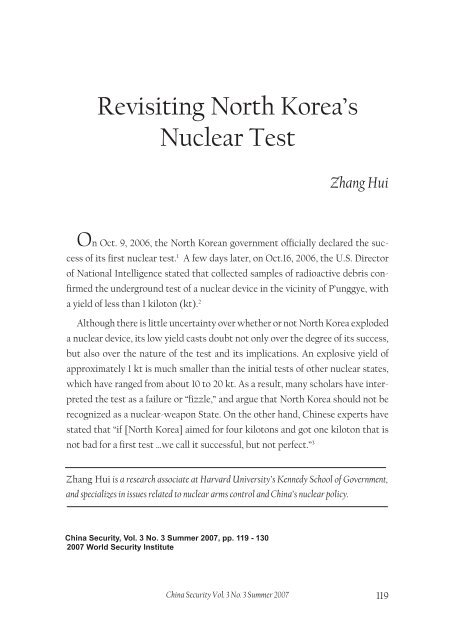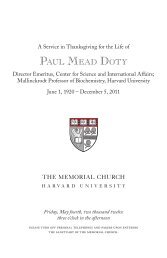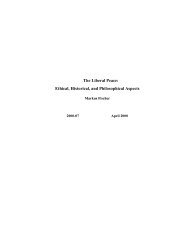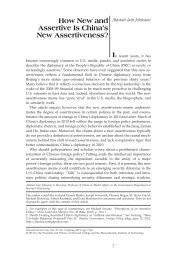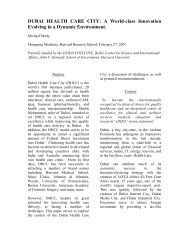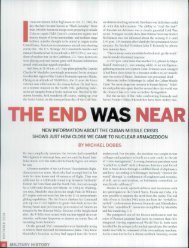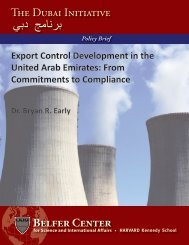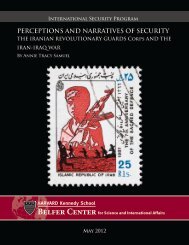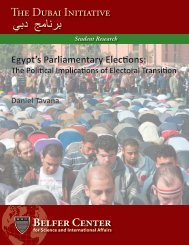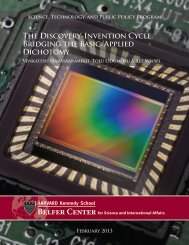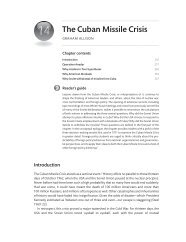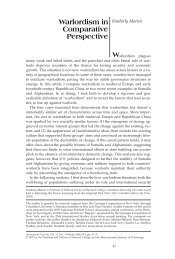Zhang Hui - Belfer Center for Science and International Affairs ...
Zhang Hui - Belfer Center for Science and International Affairs ...
Zhang Hui - Belfer Center for Science and International Affairs ...
Create successful ePaper yourself
Turn your PDF publications into a flip-book with our unique Google optimized e-Paper software.
Revisiting North Korea’s<br />
Nuclear Test<br />
<strong>Zhang</strong> <strong>Hui</strong><br />
On Oct. 9, 2006, the North Korean government officially declared the suc-<br />
cess of its first nuclear test. 1 A few days later, on Oct.16, 2006, the U.S. Director<br />
of National Intelligence stated that collected samples of radioactive debris con-<br />
firmed the underground test of a nuclear device in the vicinity of P’unggye, with<br />
a yield of less than 1 kiloton (kt). 2<br />
Although there is little uncertainty over whether or not North Korea exploded<br />
a nuclear device, its low yield casts doubt not only over the degree of its success,<br />
but also over the nature of the test <strong>and</strong> its implications. An explosive yield of<br />
approximately 1 kt is much smaller than the initial tests of other nuclear states,<br />
which have ranged from about 10 to 20 kt. As a result, many scholars have inter-<br />
preted the test as a failure or “fizzle,” <strong>and</strong> argue that North Korea should not be<br />
recognized as a nuclear-weapon State. On the other h<strong>and</strong>, Chinese experts have<br />
stated that “if [North Korea] aimed <strong>for</strong> four kilotons <strong>and</strong> got one kiloton that is<br />
not bad <strong>for</strong> a first test …we call it successful, but not perfect.” 3<br />
<strong>Zhang</strong> <strong>Hui</strong> is a research associate at Harvard University’s Kennedy School of Government,<br />
<strong>and</strong> specializes in issues related to nuclear arms control <strong>and</strong> China’s nuclear policy.<br />
China Security, Vol. 3 No. 3 Summer 2007, pp. 119 - 130<br />
2007 World Security Institute<br />
China Security Vol. 3 No. 3 Summer 2007<br />
119
A re-examination of the evidence of the North Korean nuclear explosion sug-<br />
gests that the test was likely not a failure if Pyongyang had planned <strong>for</strong> a yield<br />
of 4 kt, as it told Beijing prior to the event. If the design yield of the device was<br />
indeed 4 kt, then it is possible that North Korea was pursuing a more compact<br />
warhead, which may have profound implications <strong>for</strong> its ability to deliver a nucle-<br />
ar device with its missile capabilities.<br />
Estimating Explosive Yield<br />
In an ef<strong>for</strong>t to analyze the success of a nuclear test, it is critical to determine<br />
the actual yield of the nuclear explosion (nominal or explosive yield) as well as<br />
the yield that the device was designed to produce (design yield). A test with a<br />
1 kt explosive yield from a nuclear device with a design yield of 1 kt would, of<br />
course, be a complete success. Conversely, the same 1 kt explosive yield from a<br />
device with a design yield of 50 kt would be a failure.<br />
Without on-site measurements or North Korean cooperation, the best way<br />
to estimate the explosive yield of the Oct. 9 test is to analyze the seismic data<br />
of the explosion. Immediately following the test, reports from around the world<br />
noted a seismic wave magnitude (Mb) of between 3.5 <strong>and</strong> 4.9 on the Richter<br />
scale, equaling an estimated average seismic body wave magnitude of 4.2 ± 0.2.<br />
Naturally, a degree of uncertainty exists in the conversion of seismic magni-<br />
tude to explosive yield, which is affected by many different factors. 4 Similar seis-<br />
mic magnitude values can correspond to yields that differ by a factor of 10. For<br />
instance, variations in the geological structure of the test site can affect signal<br />
attenuation <strong>and</strong> will depend on the type of rock of the explosion cavity (hard,<br />
water-saturated rock versus dry, porous materials), or the way in which the<br />
explosion is emplaced (tamped versus detonated in a large cavity designed to<br />
muffle the signal). Also, <strong>for</strong> explosions below 10 kt it has been found that signals<br />
are not always transmitted to surrounding rock effectively, 5 thus increasing the<br />
uncertainty factor.<br />
120<br />
Revisiting NK’s Nuclear Test<br />
China Security Vol. 3 No. 3 Summer 2007
<strong>Zhang</strong> <strong>Hui</strong><br />
For known nuclear test sites, such as those in Russia, the seismic measure-<br />
ments would have an uncertainty factor of two. 6 Without better knowledge of<br />
the North Korean test site, it would be difficult to reduce uncertainty below a<br />
factor of two, especially when the test was of such a low yield. With an average<br />
magnitude value of 4.2 Mb, we can estimate the explosive yield (Y) of the North<br />
Korean test to be approximately 1 kt. 7 If we assume the more optimistic scenario<br />
of an uncertainty factor of two, then we can estimate with 95 percent confidence<br />
that the yield of North Korea’s test was between 0.5 <strong>and</strong> 2 kt. 8<br />
Nation/Organization<br />
United States<br />
U.S. Geological Service<br />
Government<br />
Los Alamos National Laboratory<br />
Columbia University<br />
South Korea<br />
Government<br />
Japan<br />
Japan Meterological Agency<br />
Kyushu University<br />
Tokyo University<br />
Russia<br />
Russian Academy of <strong>Science</strong><br />
Defense Minister Sergey Ivanov<br />
China<br />
Government<br />
Chinese experts<br />
Seismic Estimation of Explosion Yield by Country<br />
France<br />
Atomic Energy Commission<br />
Norway<br />
Norwegian Institute of Seismology<br />
NORSAR*<br />
Seismic Magnitude<br />
(Mb)<br />
4.2<br />
3.6-3.7<br />
later revised to 3.9<br />
China Security Vol. 3 No. 3 Summer 2007<br />
Reported Estimated<br />
yield (kt)<br />
1.0<br />
0.5-2.0<br />
0.2-0.7<br />
0.5<br />
later revised to 0.8<br />
4.9<br />
4.4 0.3<br />
0.5-3.0<br />
4.0<br />
4.1-4.2<br />
4.2<br />
CTBTO** 4.0<br />
5.0-15.0<br />
1.0<br />
≤ 1.0<br />
1.0-10.0<br />
*Norwegian National Data <strong>Center</strong> <strong>for</strong> verification with the Comprehensive Test Ban Treaty<br />
**Preparatory Commission <strong>for</strong> the Comprehensive Nuclear Test Ban Treaty<br />
121
Fizzle, Failure or Success<br />
Given that the yield of the North Korean test was indeed much smaller than<br />
the initial tests of other nuclear states, was the Oct. 9, 2006, test a success or<br />
failure?<br />
To answer this question, one must first assume that North Korea tested a plu-<br />
tonium device (Pu-bomb) rather than a highly enriched uranium (HEU) device. 9<br />
Little is known about North Korea’s HEU activities. It is estimated that even if<br />
Pyongyang has a dedicated HEU program, it would be at a research <strong>and</strong> devel-<br />
opment stage or, at most, have the capacity of a pilot experimental facility. Yet,<br />
even if North Korea has the capability to produce enough fissile material <strong>and</strong><br />
the necessary equipment, it would still be several years away from producing<br />
enough HEU <strong>for</strong> one or two bombs. 10 On the other h<strong>and</strong>, North Korea already<br />
has enough separated plutonium <strong>for</strong> several nuclear weapons. 11 Given this, the<br />
assumption that the device exploded on Oct. 9, 2006 was a Pu-bomb is reason-<br />
able <strong>and</strong> very likely the case.<br />
A primary difficulty with plutonium devices is the phenomenon of “pre-deto-<br />
nation.” This occurs as the plutonium-239 (Pu-239) used in nuclear devices in-<br />
evitably contains some plutonium-240 (Pu-240), an undesirable isotope as it de-<br />
cays by spontaneous fission <strong>and</strong> emits background neutrons at a high rate. The<br />
The evidence suggests the<br />
test was not a failure.<br />
Revisiting NK’s Nuclear Test<br />
high rate of neutron emission may cause the nuclear<br />
reaction not to be sustained <strong>for</strong> long enough, resulting<br />
in pre-detonation. This can happen, <strong>for</strong> example, if the<br />
detonators do not explode at the right time or if the<br />
neutron initiator misfires. 12 To reduce the probability of pre-detonation, a plu-<br />
tonium weapon would have to use an implosion device similar to the “Trinity”<br />
<strong>and</strong> “Fat Man” devices detonated over New Mexico <strong>and</strong> Nagasaki respectively,<br />
where conventional explosives surrounding the fissile material were used to rap-<br />
idly compress the mass to a supercritical state.<br />
The smallest possible yield resulting from pre-detonation is referred to as a<br />
“fizzle yield.” Nuclear expert J. Carson Mark provided a criterion <strong>for</strong> identifying<br />
122<br />
China Security Vol. 3 No. 3 Summer 2007
pre-detonation as the chain reaction of approximately e 45 fissions initiated be<strong>for</strong>e<br />
maximum criticality is achieved. 13 He estimates that in assembly systems similar<br />
to Trinity’s, the fizzle yield is approximately 2.7 percent of the design yield. Rob-<br />
ert Oppenheimer gave a similar estimate <strong>for</strong> a fizzle: around 700 tons from a 20<br />
kt nominal yield, or 3.5 percent of the design yield. 14<br />
Whether the North Korean test was a failure depends on the design yield of<br />
the device tested. If North Korea’s design yield was 20 kt, as was the case <strong>for</strong> oth-<br />
er states’ first tests, then a yield of 0.5 kt could be<br />
a fizzle yield (because the ratio of the test yield to<br />
the design yield is 2.5 percent: 0.5 kt/20 kt), which<br />
is less than the defined threshold <strong>for</strong> a fizzle yield<br />
(approximately 3 percent). However, if North Ko-<br />
rea planned a yield of 4 kt, even a test yield of 0.5 kt (12.5 percent of design yield)<br />
would not be a fizzle yield. Indeed, Chinese officials have told American nuclear<br />
experts <strong>and</strong> diplomatic officials that Pyongyang in<strong>for</strong>med Beijing in advance that<br />
they had planned to conduct an explosive test of approximately 4 kt. 15<br />
Based on Mark’s simplified model of the behavior of an implosion design 16 <strong>and</strong><br />
von Hippel <strong>and</strong> Lyman’s calculations of the probabilities of different yields, 17 we<br />
can estimate the probability of a particular explosive yield based on a given de-<br />
sign yield <strong>for</strong> the Oct. 9 North Korean nuclear test. 18 Assuming that the test used<br />
an implosion assembly system <strong>and</strong> weapons-grade plutonium (94 percent Pu-<br />
239), there was a 26 percent probability that the explosion yield would achieve<br />
the design yield of 4 kt; about 44 percent that the yield would be in excess of 2 kt<br />
(one half of the design yield); approximately 63 percent that the yield would be<br />
in excess of 1 kt; <strong>and</strong> approximately 78 percent that the yield would be in excess<br />
of 0.5 kt.<br />
<strong>Zhang</strong> <strong>Hui</strong><br />
In summary, an actual explosive yield of between 0.5 <strong>and</strong> 2 kt would not be<br />
unusual <strong>for</strong> a design yield of 4 kt. Thus, if North Korea had indeed planned to test<br />
a low-yield device on Oct. 9, it would have been neither a failure nor a fizzle.<br />
China Security Vol. 3 No. 3 Summer 2007<br />
The test may indicate that<br />
North Korea was pursuing a<br />
miniaturized warhead.<br />
123
Warhead Miniaturization<br />
Why would North Korea wish to design <strong>and</strong> test a low-yield nuclear device?<br />
Historically, when other nations developed nuclear weapons, the yields of their<br />
first tests were generally in the range of 10-20 kt, a larger size that is more man-<br />
ageable <strong>for</strong> building weapons. Also, it generally takes more than one test to wea-<br />
ponize a nuclear device <strong>and</strong> mate it to a missile. If North Korea planned a low-<br />
yield test, it could indicate that it already had confidence in its ability to explode<br />
a larger nuclear device <strong>and</strong> is pursuing a more compact warhead.<br />
It may have done this <strong>for</strong> several reasons. A smaller test could have been con-<br />
ducted <strong>for</strong> safety purposes, in an attempt to contain radioactive materials un-<br />
derground. However, it is well known that completely sealing an underground<br />
explosion cavity is actually easier with an explosion of 20 kt than <strong>for</strong> one of 1- 4<br />
kt. 20 Thus, assuming North Korean scientists knew of this fact, the safety ratio-<br />
nale <strong>for</strong> a miniaturized test (as some experts have emphasized) is negligible <strong>and</strong><br />
may even be discounted entirely.<br />
Revisiting NK’s Nuclear Test<br />
Probability of Explosive Yields based on Weapon Assembly (percent) 19<br />
Assembly System<br />
(Speed in relation to Trinity)<br />
Assembly system<br />
~ Trinity<br />
Assembly system<br />
2 x Trinity<br />
4kt >3kt >2kt >1kt >0.5kt<br />
26 33 44 63 79<br />
54 62 71 85 95<br />
Rather, if the Oct. 9 test was indeed planned as a low-yield test, it may indicate<br />
that North Korea is pursuing a miniaturized warhead. 21 Based on nuclear design<br />
experience from other countries, it can be estimated that, even without nuclear<br />
tests, North Korea would still be able to make warheads weighing between ap-<br />
proximately 500 kg <strong>and</strong> 1000 kg. For example, Sweden designed several implo-<br />
sion-type nuclear devices as light as 600 kg <strong>and</strong> with a yield of 20 kt in around<br />
1960. 22 Israel’s bomb is believed to be less than 500 kg (which was designed<br />
with only one “suspected” test). Such a low-yield nuclear test would build North<br />
Korea’s confidence in its ability to make an even more compact warhead — us-<br />
124<br />
China Security Vol. 3 No. 3 Summer 2007
ing the results of a test with an already small<br />
design yield, it could possibly pursue the devel-<br />
opment of a warhead weighing approximately<br />
500 kg or even less.<br />
<strong>Zhang</strong> <strong>Hui</strong><br />
In addition to the weight factor, the warhead<br />
must also be small enough to be mated to the<br />
appropriate missile. For that reason, weight-<br />
to-warhead size ratios should be considered.<br />
This is best estimated using an implosion Pu-<br />
bomb roughly based on the model set out by<br />
China Security Vol. 3 No. 3 Summer 2007<br />
First Nuclear Tests<br />
Nation Year Yield<br />
(kt)<br />
United States 1945 21<br />
Soviet Union 1949 20<br />
United Kingdom 1952 25<br />
France 1960 60<br />
China 1964 20<br />
India 1974 12<br />
Pakistan 1998 9<br />
Fetter et al. 23 (As a comparison, modern U.S. warheads weigh 100-200 kg <strong>and</strong><br />
have a warhead diameter of 0.28-0.48 m.)<br />
Given these weight-to-size ratios, <strong>and</strong> the payload <strong>and</strong> body diameter of<br />
North Korea’s existing missiles, the conclusion can be drawn that a warhead<br />
weighing around 500 kg could be feasibly mated to North Korea’s current Scuds<br />
(with a range that covers South Korea), Nodong missiles (with a range covering<br />
Japan), or Taepodong 1 <strong>and</strong> 2 (both of which are two-stage rockets with an even<br />
longer range). A small warhead mated with a three-stage Taepodong 2 would<br />
also provide North Korea with the range to target the continental United States<br />
(although the July 4, 2006 long-range test was the latest in a series of failed tests<br />
<strong>for</strong> that missile system). Continued testing <strong>for</strong> a compact warhead as well as<br />
testing of its long-range missiles could allow North Korea’s strategic nuclear-<br />
strike capability to exp<strong>and</strong> from its current coverage of South Korea <strong>and</strong> Japan<br />
to U.S. territory.<br />
This analysis is based on a number of estimates with considerable uncertain-<br />
ty, optimistic scenarios <strong>and</strong> relative unknowns. Yet, they all lie well within the<br />
realm of the possible <strong>and</strong> there<strong>for</strong>e lead to a number of alarming conclusions.<br />
Warhead Weight versus Diameter (Implosive Device) 24<br />
Warhead Weight (kg) 130 200 400 500 600 800 1000<br />
Diameter of Warhead (cm) 42 52 70 76 81 90 98<br />
125
If North Korea had planned a design yield of 4 kt, the test was quite likely a<br />
success. If this indicates that Pyongyang already had confidence that it could<br />
explode a simple nuclear device <strong>and</strong> is pursuing a much more compact warhead<br />
that could be mated with its current <strong>and</strong> potential missile capability, then this<br />
would have profound implications <strong>for</strong> its neighbors <strong>and</strong> the international com-<br />
munity. Since the current nuclear crisis began in October 2002, North Korea has<br />
A small warhead mated with<br />
a Taepodong 2 could reach the<br />
continental United States.<br />
continued unhindered in its ef<strong>for</strong>ts to increase its<br />
nuclear capabilities: it has produced <strong>and</strong> separated<br />
more plutonium, manufactured nuclear weapons<br />
(statements made Feb. 10, 2005), <strong>and</strong> most recently<br />
conducted a nuclear test. While the current turn of<br />
events are positive <strong>and</strong> North Korea appears more cooperative <strong>for</strong> the time be-<br />
ing, time is not on the side of those who want to halt this threat. The longer the<br />
crisis lasts, the greater North Korea’s nuclear capability will be, <strong>and</strong> the higher<br />
the stakes <strong>for</strong> all. There<strong>for</strong>e, resolving this nuclear crisis is an urgent matter that<br />
must be addressed immediately.<br />
126<br />
Revisiting NK’s Nuclear Test<br />
China Security Vol. 3 No. 3 Summer 2007
Taepodong-2<br />
(three-stage)<br />
~15000<br />
400-600<br />
--<br />
--<br />
Unknown<br />
North America<br />
Taepodong-2<br />
3500-6000<br />
700-1000<br />
2.2/1.3<br />
~5<br />
Unknown<br />
>6000km<br />
Hawaii, Alaska<br />
Taepodong-1<br />
1500-2500<br />
1000-1500<br />
1.3/0.88<br />
~15<br />
Yes<br />
<strong>Zhang</strong> <strong>Hui</strong><br />
Nodong<br />
1350-1500<br />
770-1200<br />
1.30<br />
~100<br />
Yes<br />
Japan<br />
Scud C<br />
500<br />
770<br />
0.89<br />
~300<br />
Possibly<br />
South Korea<br />
China Security Vol. 3 No. 3 Summer 2007<br />
Sud B<br />
320<br />
1000<br />
0.89<br />
~100<br />
Possibly<br />
partial South<br />
Korea<br />
Range (km)<br />
Payload<br />
(km)<br />
Body Diameter (m)<br />
Inventory<br />
Compatable?<br />
Potential<br />
Target<br />
North Korean Ballistic Missiles <strong>and</strong> Potential Nuclear Strike Capability 25 127
Revisiting NK’s Nuclear Test<br />
Notes<br />
1 The Korean Central News Agency, the official government news agency, issued the following<br />
statement: “The field of scientific research in the DPRK [North Korea] successfully<br />
conducted an underground nuclear test under secure conditions on Oct. 9, Juche 95 (2006),<br />
at a stirring time when all the people of the country are making a great leap <strong>for</strong>ward in the<br />
building of a great, prosperous, powerful socialist nation. It has been confirmed that there<br />
was no such danger as radioactive emission in the course of the nuclear test as it was carried<br />
out under scientific consideration <strong>and</strong> careful calculation.” For the full press release, see<br />
“DPRK Successfully Conducts Underground Nuclear Test,” Korean Central News Agency, Oct. 9<br />
2006, see http://www.kcna.co.jp.<br />
2 “Statement by the Office of the Director of National Intelligence on the North Korea Nuclear<br />
Test,” ODNI News Release No. 19-06, Oct. 16, 2006. See http://www.odni.gov.<br />
3 Hecker, Siegfried, “Report on North Korean Nuclear Program,” Policy Forum Online 06-97A,<br />
(San Francisco: Nautilus Institute, Nov. 15, 2006), http://www.nautilus.org/<strong>for</strong>a/security/<br />
0697Hecker.html.<br />
4 “Seismic Verification of Nuclear Testing Treaties,” Office of Technology Assessment, OTA-<br />
ISC-361, (Washington, D.C.: Office of Technology Assessment, May 1988), http://www.wws.<br />
princeton.edu/ota/ns20/year_f.html.<br />
5 Ibid.<br />
6 The factor of uncertainty <strong>for</strong> a given measurement is defined as that number which, when<br />
multiplied by or divided into an observed yield, bounds the range which has a 95 percent<br />
chance of including the actual (but unknown) value of the yield (see ibid). A combined Mb<br />
(body wave) <strong>and</strong> Ms (surface wave) approach may reduce the uncertainty factor to 1.3.<br />
7 It should be noted that, <strong>for</strong> different design yields, the relationship between explosive yield<br />
Y (in kt) <strong>and</strong> magnitude (Mb) could be different. There is no <strong>for</strong>mula <strong>for</strong> very low design<br />
yield (less than 5 kt). If we apply relation <strong>for</strong> 5.3kt
<strong>Zhang</strong> <strong>Hui</strong><br />
clear Forensics,” Arms Control Today, January/February 2007, http://www.armscontrol.org/<br />
act/2007_01-02/LettertoEditor.asp).<br />
10 <strong>Zhang</strong>, <strong>Hui</strong>, “Chinese Perspectives on the North Korean Nuclear Issue,” Paper presented<br />
at the Institute of Nuclear Materials Management 46th Annual Meeting, (Phoenix, Arizona:<br />
July 10-14, 2005.) See http://bcsia.ksg.harvard.edu/BCSIA_content/documents/China_NK_<br />
paper_<strong>Hui</strong><strong>Zhang</strong>05.pdf.<br />
11 See, e.g., Albright, D. <strong>and</strong> P. Brennan, “The North Korean Plutonium Stock Mid-2006,”<br />
Institute <strong>for</strong> <strong>Science</strong> <strong>and</strong> <strong>International</strong> Security Report (Washington, D.C.: Institute <strong>for</strong> <strong>Science</strong> <strong>and</strong><br />
<strong>International</strong> Security, June 26, 2006) http://www.isis-online.org/publications/dprk/dprkplutonium.pdf.<br />
12 Garwin, R. <strong>and</strong> F. von Hippel, “A Technical Analysis of North Korea’s Oct. 9 Nuclear Test,”<br />
Arms Control Today, November 2006. See http://www.armscontrol.org/act/2006_11/NKTest-<br />
Analysis.asp.<br />
13 J. Carson Mark was the director of the Theoretical Division at Los Alamos National Laboratory,<br />
1947-1972. See, Mark, J. Carson, “Explosive Properties of Reactor-Grade Plutonium,”<br />
<strong>Science</strong> <strong>and</strong> Global Security, Vol. 4 No. 1, (1993), pp. 111-124.<br />
14 Robert Oppenheimer discussed a fizzle yield: “The possibility that the first combat plutonium<br />
Fat Man will give a less than optimal per<strong>for</strong>mance is about 12 percent…<strong>and</strong> about 2<br />
percent chance that it will be under 1,000 tons. It should not be much less than 1,000 tons<br />
unless there is an actual malfunctioning of some of the components.” See ibid.<br />
15 The author had confirmed this with Christopher Hill, chief U.S. negotiator <strong>for</strong> the Six Party<br />
Talks, when he spoke at Harvard’s Kennedy School of Government; see also Hecker, Siegfried,<br />
“Report on North Korean Nuclear Program”, Policy Forum Online 06-97A, (San Francisco:<br />
Nautilus Institute, Nov. 15, 2006.) See http://www.nautilus.org/<strong>for</strong>a/security/0697Hecker.<br />
html. In addition, some scholars may argue that Pyongyang may have been lying about its<br />
design yield to Beijing <strong>for</strong> various reasons. For example, if lacking confidence in a higher test<br />
yield from a larger design yield, Pyongyang may have understated the design yield so that a<br />
lower explosive yield would still show the test a success. However, this is unlikely as the lie<br />
would have been revealed under several scenarios including an explosive yield near or greater<br />
than 4 kt. The balance of the evidence suggests it would have been unlikely <strong>for</strong> Pyongyang to<br />
run such a risk.<br />
16 Mark, J. Carson, “Explosive Properties of Reactor-Grade Plutonium,” <strong>Science</strong> <strong>and</strong> Global Security,<br />
Vol. 4 No. 1, (1993), pp. 111-124.<br />
17 Von Hippel, F. <strong>and</strong> E. Lyman, “Appendix: Probabilities of Different Yields,” <strong>Science</strong> <strong>and</strong> Global<br />
Security, Vol. 4 No. 1 (1993) pp. 125-128.<br />
18 My estimations are based on the following assumptions: the device contained about 6 kg<br />
Weapons-grade Plutonium (WGPu: 6 percent Pu-240); spontaneous fission (SF) neutrons<br />
produced at rate of 3* 105 /sec; t =10 0 -5 s (t : the time interval through which the system is<br />
0<br />
supercritical prior to completion of the assembly as the shock wave from the high explosive<br />
reaches the center); t=10-8s (t: the lifetime of a fission neutron); <strong>and</strong> that the designed yield<br />
was 4 kt, as Beijing had been told.<br />
19 Assuming North Korea used 6 kg of WGPu, with a design yield 4 kt.<br />
20 Hecker, Siegfried, “Report on North Korean Nuclear Program,” Policy Forum Online 06-97A,<br />
(San Francisco: Nautilus Institute, Nov. 15 2006.) See http://www.nautilus.org/<strong>for</strong>a/security/<br />
China Security Vol. 3 No. 3 Summer 2007 129
Revisiting NK’s Nuclear Test<br />
0697Hecker.html.<br />
21 It should be noted that there is not an explicit relationship between either warhead weight<br />
or size <strong>and</strong> the warhead yield. However, past nuclear tests by other nuclear states show a<br />
rough trend that lower-yield tests could be aimed at pursuing lighter warheads. Here, I assume<br />
the possibility that this trend could fit the North Korean test situation. See “Complete<br />
List of All U.S. Nuclear Weapons” The Nuclear Weapons Archive, Oct. 16, 2006. See http://nuclearweaponarchive.org/Usa/Weapons/Allbombs.html.<br />
22 Sweden had terminated the program by 1965.<br />
23 It should be noted that this article assumes that the first North Korean test device was designed<br />
with the Nagasaki-type solid core as discussed by Mark (Mark, J. Carson, “Explosive<br />
Properties of Reactor-Grade Plutonium,” <strong>Science</strong> <strong>and</strong> Global Security, Vol. 4 No. 1, (1993), pp. 111-<br />
124), which has no behavioral relationship to the design of the Fetter et al hollow-core design<br />
as discussed here: Fetter, S., Frolov, V., Miller, M., Mozley, R., Prilutsky, O., Rodionov, S. <strong>and</strong><br />
R. Sagdeev, “Detecting Nuclear Warheads,” <strong>Science</strong> <strong>and</strong> Global Security, Vol. 1 No. 3-4, (1990)<br />
pp. 225-302. A more consistent approach may be needed to start with the Nagasaki design<br />
<strong>and</strong> try to estimate how much the yield would have been reduced if one reduced the tamper<br />
<strong>and</strong> high-explosive mass. However, we can assume that if North Korea continued to pursue<br />
warhead miniaturization, it could develop the Fetter et al hollow-core design in the future.<br />
130<br />
WgPu: 4 kilograms<br />
5 centimeters outside radius<br />
0.75 centimeters thick<br />
fissile core (WgU or WgPu)<br />
beryllium reflector, 2 cm<br />
tamper (tungsten or uranium), 3cm<br />
high explosive, 10 cm<br />
aluminum case, 1 cm<br />
24 See, e.g., Li, Bin “Nuclear Missile Delivery Capabilities in Emerging Nuclear States,” <strong>Science</strong><br />
<strong>and</strong> Global Security, Vol. 6 No. 3,(1997) pp. 311-331; Fetter, S., Frolov, V., Miller, M., Mozley, R.,<br />
Prilutsky, O., Rodionov, S. <strong>and</strong> R. Sagdeev, “Detecting Nuclear Warheads,” <strong>Science</strong> <strong>and</strong> Global<br />
Security, Vol. 1 No. 3-4, (1990) pp. 225-302.<br />
25 “North Korea Missiles” See http://www.globalsecurity.org/wmd/world/dprk/missile.htm.<br />
China Security Vol. 3 No. 3 Summer 2007


